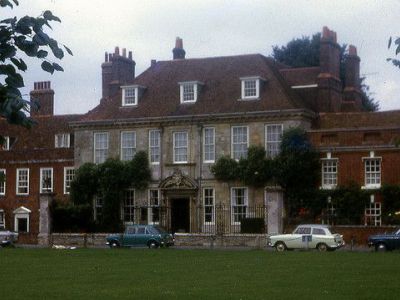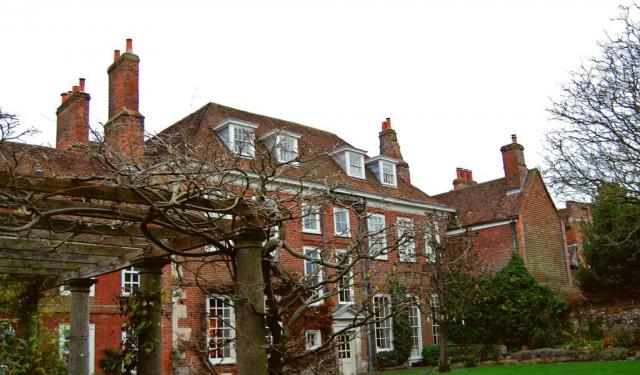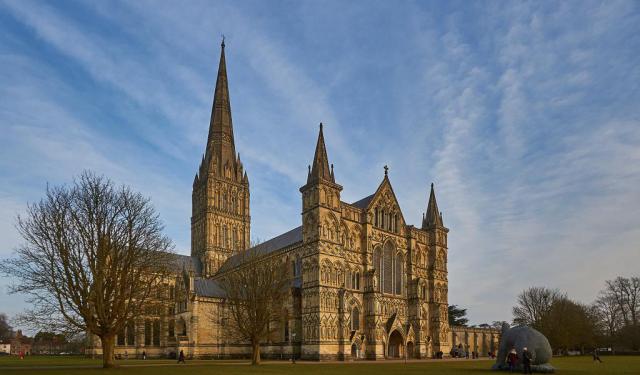
The Bishop's Palace, Salisbury
The Bishop’s Palace is one of Salisbury's oldest buildings, yet not all that well-known. Hidden behind tall walls and gates, with only faint glimpses of stonework seen through the trees planted in front of it, it is presently better known as Salisbury Cathedral School. Access to the grounds is limited to students and staff, with only rare openings to the public.
The property was started around 1219, around the same time as the cathedral itself, by Bishop Richard Poore to become his first residence (as well as the first edifice erected within The Close). It was initially, and rather unimaginatively so, referred to as 'New Place'. The original building, rather simple, was later added to and altered by subsequent bishops until it gained its present form – a series of irregular structures – the most striking of which is the tower with crenallated turret resulted from a large overhaul in the late 15th or early 16th century.
A 15th-century bedchamber was converted into a Tudor chapel in the mid-16th century (first documented in 1588). Parts of the palace were demolished after 1648, with the surviving elements converted into an inn and tenements. Fragment of the original building has survived in the vaulted undercroft, known as Bishop Poore's Hall. Restored by Bishop Wordsworth in 1889, it was used by Bishop Wordsworth School.
During the Commonwealth period, from 1649 to 1660, the palace was let out in tenements, one of which was kept as an inn by a Dutch tailor. After these depredations the house was completely restored by Bishop Seth Ward. The gardens were laid out and a lake formed in the mid-19th century, at which time the stables and an entrance lodge were added.
Parts of the property were demolished in 1931, and in 1947 the Church Commissioners exchanged the palace with the dean and chapter for Mompesson House. The palace then became the premises of the Cathedral School, and the bishop moved his residence, for a time, to Mompesson House.
Presently, displayed inside the palace is a collection of portraits of all the Bishops of Salisbury.
The property was started around 1219, around the same time as the cathedral itself, by Bishop Richard Poore to become his first residence (as well as the first edifice erected within The Close). It was initially, and rather unimaginatively so, referred to as 'New Place'. The original building, rather simple, was later added to and altered by subsequent bishops until it gained its present form – a series of irregular structures – the most striking of which is the tower with crenallated turret resulted from a large overhaul in the late 15th or early 16th century.
A 15th-century bedchamber was converted into a Tudor chapel in the mid-16th century (first documented in 1588). Parts of the palace were demolished after 1648, with the surviving elements converted into an inn and tenements. Fragment of the original building has survived in the vaulted undercroft, known as Bishop Poore's Hall. Restored by Bishop Wordsworth in 1889, it was used by Bishop Wordsworth School.
During the Commonwealth period, from 1649 to 1660, the palace was let out in tenements, one of which was kept as an inn by a Dutch tailor. After these depredations the house was completely restored by Bishop Seth Ward. The gardens were laid out and a lake formed in the mid-19th century, at which time the stables and an entrance lodge were added.
Parts of the property were demolished in 1931, and in 1947 the Church Commissioners exchanged the palace with the dean and chapter for Mompesson House. The palace then became the premises of the Cathedral School, and the bishop moved his residence, for a time, to Mompesson House.
Presently, displayed inside the palace is a collection of portraits of all the Bishops of Salisbury.
Want to visit this sight? Check out these Self-Guided Walking Tours in Salisbury. Alternatively, you can download the mobile app "GPSmyCity: Walks in 1K+ Cities" from Apple App Store or Google Play Store. The app turns your mobile device to a personal tour guide and it works offline, so no data plan is needed when traveling abroad.
The Bishop's Palace on Map
Sight Name: The Bishop's Palace
Sight Location: Salisbury, England (See walking tours in Salisbury)
Sight Type: Attraction/Landmark
Guide(s) Containing This Sight:
Sight Location: Salisbury, England (See walking tours in Salisbury)
Sight Type: Attraction/Landmark
Guide(s) Containing This Sight:
Walking Tours in Salisbury, England
Create Your Own Walk in Salisbury
Creating your own self-guided walk in Salisbury is easy and fun. Choose the city attractions that you want to see and a walk route map will be created just for you. You can even set your hotel as the start point of the walk.
Historical Houses Tour
Founded more than 800 years ago, Salisbury understandably has a great number of historical, architectural, and cultural gems worthy of a visit. The medieval houses, churches, inns, and hospitals blend harmoniously with the modern sites of the city.
Your exploration of these treasures can be started at Trinity Hospital, a picturesque almshouse founded in the 14th century, offering a glimpse... view more
Tour Duration: 1 Hour(s)
Travel Distance: 1.5 Km or 0.9 Miles
Your exploration of these treasures can be started at Trinity Hospital, a picturesque almshouse founded in the 14th century, offering a glimpse... view more
Tour Duration: 1 Hour(s)
Travel Distance: 1.5 Km or 0.9 Miles
Cathedral Close Tour
Salisbury Cathedral, apart from being renowned as the holder of Britain’s tallest spire, the world’s best preserved original copy of Magna Carta (1215) and Europe’s oldest working clock, is also famous for its Close, the largest in the country, measuring 80 acres (or 32 hectares).
The areas surrounding cathedrals' grounds, sometimes extending for hundreds of meters from the main... view more
Tour Duration: 1 Hour(s)
Travel Distance: 1.2 Km or 0.7 Miles
The areas surrounding cathedrals' grounds, sometimes extending for hundreds of meters from the main... view more
Tour Duration: 1 Hour(s)
Travel Distance: 1.2 Km or 0.7 Miles
Salisbury Introduction Walking Tour
Salisbury’s roots lie in Old Sarum, an Iron Age hillfort located about two miles from today’s city center. The Romans and Saxons each left their mark on this ancient settlement, which became a significant town by the 11th century. After the Norman Conquest in 1066, Old Sarum grew into a fortress town, hosting a castle and becoming the seat of the Salisbury Bishopric in 1075. Yet the site’s... view more
Tour Duration: 1 Hour(s)
Travel Distance: 1.7 Km or 1.1 Miles
Tour Duration: 1 Hour(s)
Travel Distance: 1.7 Km or 1.1 Miles



